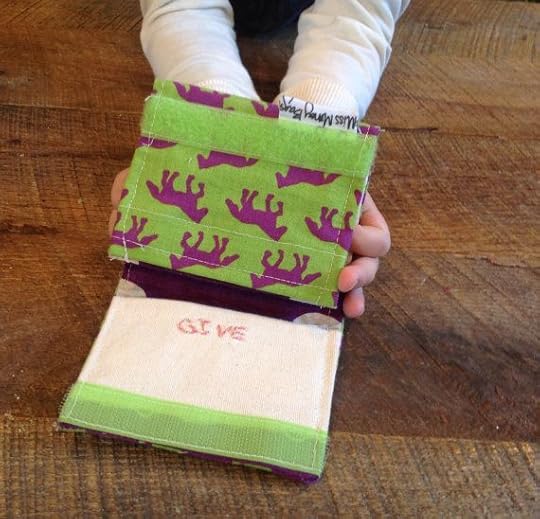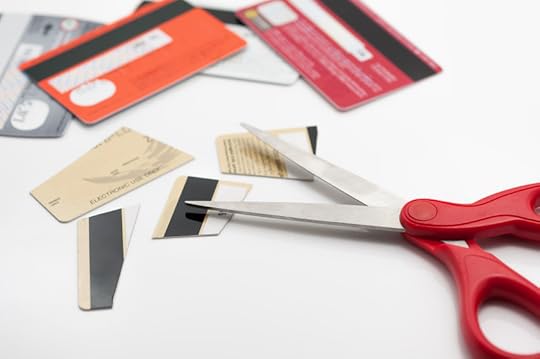Ruth Soukup's Blog, page 52
December 16, 2016
The Essential Rules of Friendship

As kids, potential friendships are all around us, from the creative girl across the street to the friendly kids in our second grade class.
But as we get older, finding close friends isn’t so easy, is it? Between running the kids to lessons and activities, and finding time to get everything done, we can sometimes overlook the opportunity to make a real connection when a fellow mom reaches out or when a neighbor offers to lend a helping hand.
For me, each time I moved across the country, I truly struggled to make friends. Sometimes I didn’t quite know how to connect or find common ground. Sometimes it was really hard for me to simply meet new people. Friendship can feel so much more complicated as a grownup.
…but, is it really?
As adults, don’t we, at heart, seek the same qualities we did when we were kids? We’re looking for someone with common interests, who is kind and compassionate, who we like spending time with. Someone who listens and gives us an unbiased and honest opinion. Someone we look up to and enjoy being around.
Whether you’re looking to expand your social circle, wondering which relationships might be worth more of your time, or trying to find a true connection amidst a flurry of Facebook friends, it can help to think about it this way: What really makes a true friend? …and how can we take that next step toward true friendship?

1. They “Get” You
A true friend “gets” you. They understand your humor and they click with you. They can pick up on your moods and intuitively understand if something’s bothering you or if you’re going through a rough time.
Friends really don’t need to be your same age or have your same lifestyle to “get you.” You might not share a career or a church. You might both be moms, but maybe not. The “click” is something beyond quantification or measurement. It’s about someone who can make you laugh and holds your interest.
When you see an old friend after years of living apart, are you ever amazed at the way you can pick right up where you left off? A true friend can pick up on inside jokes and stories right away.
Cultivate your connection by telling your friend when you’re thinking about them. Send a quick picture and a text when you see something in the store that reminds you of your shared connection. Make your friend a card and tuck in a photo of something the two of you shared. Forward an article you think they’ll like as much as you did. Keep your connection strong by revisiting jokes and your “friend language,” and reminisce with them whenever you have the chance.
2. They Listen
Good friends are great at listening. They can get you through a challenging time—the worst of times, in fact—by simply being there for you. When you hit a dark point, they’re the voice you can hear to help guide you through the darkness or to simply remind you that you aren’t alone.
When things are sunny or when you don’t need someone to “vent” to, your listening friends can feel a little neglected. On the other hand, some of us have a friend we use as our constant sounding board and emotional support, which is great for us but can get draining and difficult for them.
If you want to strengthen your friendship with that friend who listens to you all the time, return the favor. Learn how to be a better listener. Check yourself in conversation—do you interrupt or do you listen to their story with the same rapt attention they give you? Do you offer unsolicited advice or do you simply acknowledge their feelings and wait until they ask for your guidance?
Good listeners know how to relate without bossing someone around or telling them, “Well, I would do this,” or “You should do that.” They simply hear you out and give you a chance to say what you need to say.
If you have a friend who won’t let you get a word in edgewise, try leading by example. Be a better listener and give them your full attention. When the tables are turned, start the conversation by saying, “I just need to vent this out,” or “I’m not looking for advice, but I just need to talk through what’s going on.” Hopefully, you’ll find they lend you an ear.

3. You Have Commonalities
Common interests and lifestyles are important for friends. Not all friends will have everything in common, but it’s so important to have friends who know what you’re going through and who can relate. It’s also great to have friends who love to do the things you enjoy as well. If you love theater or baseball or Indie rock, having a friend to enjoy it with can be the icing on the cake.
Strengthen your common bonds by doing things together you both enjoy. If you’re both moms of similar-aged kids, playdates can be wonderful and give you a chance for some adult conversation while the kids romp around. If your spouses get along too, it can be great to have a couple to double-date with on occasion.
Make an effort to revisit the things the two of you like doing together and enjoy them regularly. While maybe it’s not practical to fly to New York for every Broadway musical, you can forward your friend a YouTube clip from Hamilton or send them an article on the latest buzz. Go see a local play together to feed your mutual theater bug.
4. You Have Differences
On paper, I’m actually quite different from many of my closest friends. We might be years apart in age or have different relationship statuses. Not all my friends have kids or even want children. Many of us have different tastes in entertainment, music, sports and recreation.
Embrace these differences and use them as a great way to learn new things and relate in different ways. I love learning from my friends’ different talents. One of my friends is quite the foodie, so she gives me tips on ways to punch up my “down home” cooking style. I have another friend who’s a talented seamstress. She gives me plenty of ideas on how to alter clothing and find new uses for items.
Differences are what make our friends interesting and fascinating to us. I mean, how boring would it be if we were all the same?! If you have a friend who knows something you don’t or has a specific talent, see if you can learn something new from them! Support your friend in their endeavors and embrace your differences and multifaceted strengths.

5. You Keep in Regular Contact
When we were kids, we were friends with the other kids in our neighborhood and school classes. Why? Because those were the people we saw regularly. As adults, we’re far more mobile, but the same concept still applies. If we want close friends, we have to make an effort to reach out…which can be super hard when we feel crazy-busy all the time.
Instead of rearranging your entire schedule (because who can do that anyway?), think of ways to spend time together that already fit right into your schedule. You don’t have to spend money on outings, just do your everyday activities. Go to Costco together and talk while you shop. Take an exercise class together or join the same gym. Volunteer on the same committee at church or at school. It’s not about always sitting around together, or going to dinner or a movie. You can learn to incorporate your to-do list into your friend activities—it’s win-win.
If your friend lives out of state so your schedule truly won’t allow for “hanging out,” it can still really help to try to make regular contact. This might mean emails, phone calls, a note in her mailbox, or a “thinking of you” text. Do little things to make one-on-one contact to let your friend know they’re on your mind even if they’re far away.
6. You Inspire Each Other
A true friend is someone you look up to. It doesn’t mean your bestie is perfect or runs a non-profit foundation or anything like that. (Although, that’s great!) It simply means they inspire you. Maybe you’re wowed by their business prowess or drive. Maybe you learn from their creativity or their patient approach to motherhood. Maybe their spirituality and philosophy inspires you to want to do better in your daily life.
Look for friends with qualities you admire and hope to emulate. When we surround ourselves with good people, we become better as well. Our friends can inspire us to roll up our sleeves and pitch in, to run a race, or to speak with more kindness to our kids.
When you notice something your friend does that truly speaks to you and touches your heart, let her know! Practice an attitude of gratitude and tell your friend how much their approach to their hobby inspires you or how much you look up to them. I know it can feel a little awkward sometimes, but I promise they’ll appreciate it!

7. You Challenge Each Other
Just like our friends can inspire us, they can also challenge us and push us beyond our boundaries. A true friend helps you learn and grow. They don’t just show us by example—they also encourage us to strive harder and work for what we want.
Talk to your friends about what you want to do. Tell them your goals and what sort of challenges you’ve laid out for yourself. Then ask them if they’ll help you. If they’re up for the idea, ask them if they want to tackle the goal along with you.
Maybe you’re hoping to get your finances under control. Maybe you want to lose 10 pounds this season or maybe you want to finish a project you’re working on at your job. Whatever your goals are, tell your friend. Ask them if they’d be willing to be your accountability buddy. If they express interest in doing something similar, ask them if they’d be up for the challenge and you’ll return the favor.
8. You’re Loyal ‘til the End
Friends are loyal. Friends don’t gossip about each other or betray a trust. Friends have each other’s backs. When a friend needs help, they should know they can count on you and vice versa. If someone messes up, they should know they can be forgiven—and vice versa when you’re quick to apologize and make amends.
Friendship is almost like a contract. You’re saying, “I’m agreeing to be emotional and open with you, if you’ll be emotional and open with me. I will trust you if you trust me.” Part of the contract of friendship is learning to say you’re sorry and being aware of your friend’s feelings. A true friend never says something behind another’s back that they wouldn’t say to them up front and directly.
It can be hard to hold your tongue and be really loyal, especially if you’re friends with a larger group or have several relationships that are intertwined. Remember, it comes down to respect—and respecting and loving your friends means being honest and kind. If a friend has let you down, let them know. If you put your foot in your mouth (I know I have!), express your regret and commit to it not happening again. Keep your friendship contract honest and honored.
Friends are so important to our lives. They enrich us and push us to be better human beings. They keep us involved and give us time to feel happy, a shoulder to cry on, and an ear when we need someone to listen. A true friend is indispensable—because although our relationships may change and fluctuate throughout life, we’re often blessed with a few relationships that transcend life’s ups and downs. When you treat your friends like gold, they’ll return the favor!

Pin It
The post The Essential Rules of Friendship appeared first on Living Well Spending Less®.
December 14, 2016
Easy French Onion Soup

When the weather is cold nothing quite hits the spot like a bowl of hot soup! This freezer friendly French Onion Soup comes together surprisingly fast, but the yummy toppings make it feel extra special. It is also a great dish to serve for a light lunch, casual dinner or along side your favorite baked chicken recipe.

Here is what you need:
4 cups sweet onions or Vidalia if in season, sliced
1/2 cup butter
2 cartons Beef stock
salt and pepper to taste
Gruyère, sliced cheese( cooking day only)
Italian bread, sliced (cooking day only)
fresh or dried thyme

Step 1: Slice onions and set aside.

Step 2: Melt butter and saute 2 cups of onions in butter until soft and golden brown. Set aside and let cool.

Step 3: In a large bowl mix together sauteed onions, raw sliced onions and stock, then divide into gallon size bags. (be sure to label bags first). Freeze until needed.

Step 4: Cook in slow cooker on high for 3-4 hours or on low for 4-5. Be sure to season with salt and pepper.

Step 5: Once ready to serve; slice bread, butter it and toast.

Step 6: Then ladle soup into crocks top with bread then cheese and place under broiler for 1-2 minutes to melt cheese.

Step 7: Once melted, sprinkle with some fresh Thyme and serve hot.
Print This!
Recipe: Freezer French Onion Soup
Summary: This classic soup is made freezer friendly and tastes absolutely amazing!!
Ingredients
4 cups sweet onions or Vidalia if in season, sliced
1/2 cup butter
2 cartons Beef stock
salt and pepper to taste
Gruyère, sliced cheese( cooking day only)
Italian bread, sliced (cooking day only)
fresh or dried thyme
Instructions
Slice onions and set aside.
Melt butter and saute 2 cups of onions in butter until soft and golden brown. Set aside and let cool.
In a large bowl mix together sauteed onions, raw sliced onions and stock, then divide into gallon size bags. (be sure to label bags first). Freeze until needed.
Cook in slow cooker on high for 3-4 hours or on low for 4-5 hours. Be sure to season with salt and pepper.
Once ready to serve; slice bread, butter it and toast.
Then ladle soup into crocks top with bread then cheese and place under broiler for 1-2 minutes to melt cheese.
Once melted, sprinkle with some fresh Thyme and serve hot.
Preparation time: 5-7 minutes
Cooking time: 3-4 hours on low 4-5 hours
Number of servings (yield): 4

Pin It
The post Easy French Onion Soup appeared first on Living Well Spending Less®.
December 12, 2016
Maxmize Your Credit Card Rewards

This past summer, my family and I moved from Florida to Washington State. That’s no small trek. And, because it was summer, we decided to take our time and see as many sights along the way as we could, everything from the Florida Caverns in the panhandle to Nashville, Tennesee to Indianapolis and Chicago, then on to the Wisconsin Dells, Mount Rushmore, and Yellowstone.
All in all, we spent 3 1/2 weeks on the road and covered more than 4,000 miles.
It was SO much fun! And aside from one night spent at a friend’s house along the way, we stayed in really nice hotels the whole time–the Westin, the Hilton, the Sheraton, the Marriott, the DoubleTree. In other words, there was no roughing it! We traveled the country in as much style as our jam-packed 2002 Tahoe would allow.
So how did we afford it?
With the exception of our 3 nights at Yellowstone (where we shared a KOA cabin with my sister’s family), we used reward points, and got more than $4,000 in hotel stays completely FREE.
Crazy right?
At some point, many of us have signed up for a credit card due to the claim of some sort of promised reward, be it 10,000 airline miles or travel points, Disney dollars or cash back rewards, or, in the case of department stores, an extra discount as we made a big purchase. Maybe we were even swayed by the promise of a free blanket or a stuffed animal.
Then what happens? We end up with a massive annual fee we didn’t know about or we find out the interest rate is through the roof. We can’t pay off our balance and we end up with late fees or worse, all adding to our debt.
Here’s the secret: credit card rewards aren’t there to benefit the consumer. They’re there to entice you. They’re there to get you to spend more and stretch your budget. …I dare say they’re even there to trick you with fine print, limited offers, blackout dates on travel, and complicated point systems created to ensure you just give up.
So is it worth it?
Just like “extreme couponers,” there are “extreme mileagers” or “travel hackers”—people who’ve figured out the secret to accruing major airline miles and rewards, then cashing them in for unheard of bonuses. There’s even a guy who found a “pudding loophole.” He spent $800 on pudding (donated to charity for a tax break) to receive a lifetime supply of airline miles. Basically, to get crazy, free money deals, you need to invest time, research and dedication. It’s similar to day trading: it requires attention and a love of figuring out puzzles.
For most of us, these extreme deals aren’t realistic, but taking advantage of simple rewards just might be, especially if you own your own business or have large expenses that can be paid on a credit card. After all, it’s essentially free money—and who doesn’t want a little of that?
But be fair warned–there is a big downside to credit cards! It is easy to overspend and to get yourself in trouble, so if money and spending is a struggle, don’t risk it. That said, if your finances are organized, you have savings, you’re good at budgeting and self control, and you are in a good financial place, then there are some great opportunities you can take advantage of to earn rewards.
Here are some smart strategies and tips to keep in mind.

1. Don’t Carry a Balance
The biggest key to taking advantage of credit card rewards is to never carry a balance. You MUST pay off the credit card each month or the interest you accrue will completely negate any reward you might receive. This is essential!!
Keep in mind, credit card companies are banking on the idea that you’ve been lured in by the promise of a reward. They expect you to bite off more than you can chew (and pay back). That’s the whole point of these “rewards” offers. By paying off the balance each month, you’re ensuring interest doesn’t add up to more than the reward you’re trying to earn.
2. Watch the Annual Fee
Many airline rewards cards have an annual fee. Some cash-back and other bonus cards don’t. Pay close attention to the annual fee—especially because many credit card companies wave the fee for the first year (so it’ll only come back to haunt you later on). For some people, a $50 fee is well worth the rewards they can reap. In other cases, an annual fee would certainly cancel out any advantage. Understand what you are getting–and do the math to find out whether the fee will pay off or not.
There are also some debit cards that offer bonuses and rewards without the fear of accruing an annual fee or interest. Do the research beforehand to ensure you’re not surprised later on.

3. Look for Signing Bonuses
Many mileage cards offer very enticing sign-up bonuses. As long as you have a healthy credit score, most credit experts say you can safely sign up for 4-6 cards per year and cancel them later without experiencing permanent adverse effects to your score. However, be very careful! Check if you must have the card open for a certain amount of time before reaping the rewards. Some cards require you leave the card open for three to six months to gain any rewards, which can be a challenge to manage.
Credit card companies offer mega-miles for signing bonuses these days, so shop around and see what you can find. NerdWallet offers this helpful list of the credit cards with the best bonuses and rewards available.
4. Manage Your Miles Carefully
Sites like AwardWallet and MileageManager can help you keep track of miles. Many reward miles expire after a year or two. There are also blackout dates and restrictions on when and how you can cash-in those bonus miles. If you’re planning a trip during Christmas or over the summer, you might be disappointed to find those dates are unavailable under your rewards restrictions.
A mile management app or website can really help you keep an eye on expiration dates and see what’s available when you’re ready to travel. It can also help you know when to upgrade, as well as provide ideas for other ways to use your miles, especially if you travel frequently for business.

5. Find Rewards You’ll Actually Use
If you rarely travel, then a credit card with mileage rewards or hotel points might be the wrong benefit for you. There are credit cards that offer discounts on concert tickets, or cash back on groceries, gas, retail and even leisure activities.
Find a card with bonuses and rewards that really speak to you. If you’ve accrued miles you don’t want to use, you can trade them in at sites like points.com, but be aware that between the spending for points and trading points for gift cards, you might take a loss. (However, it’s better than letting the points just expire.) There are also savings rewards cards that can help you put more money toward your retirement account or college savings. It might not be as glamorous and fun as travel miles, but it can be a sound investment.
6. Spend in the Right Place
Taking advantage of rewards might mean carrying several cards at once. You may have to have a card for gas, one for groceries, and one for dining out because you only earn certain rewards for each card. Keep careful track of which cards do what. Using a gas rewards card can earn you major rewards when you fill up, a grocery rewards card may only work at certain stores, and retail cards may only give you bonus points, discounts and rewards from certain retailers.
When you open a card, you might need to spend a certain amount right away to maximize your points. Consider purchasing gift cards to Amazon or another frequently used retailer. That way, you’re buying something you’re going to spend money on anyway. The trick is you just need to pay off the credit card balance right away.
Find out if, in lieu of cash, you can pay babysitters, dogwalkers and others with Venmo or Amazon Payments. Anywhere you use cash, you can be earning points instead (and socking that cash away to pay your bill at the end of the month).

7. Be Generous
You can also take advantage of credit card points by putting down your card when you go out to dinner with a friend. If your friend has cash, offer to put the entire bill on your card. Go even further “footing the bill” by signing up with organizations like Kiva.org to support microloans for business owners to meet your minimum spend requirement. (The borrower pays you back over time, so you must have the money to pay off the credit card on hand.)
There are also options for donating your reward points to charities. If your miles or points are about to expire and you can’t find a way to use them, consider donating. Donations are tax-deductible and are very useful for those in need. An estimated $16 billion in credit card points and rewards go unclaimed each year. Put those points to good use!
8. Look for Helpers
Before you visit a retailer or go out to eat, check your credit rewards site for a portal or link. Apps like iDine can help you earn extra rewards whenever you go out to eat.
If you go through the shopping portal on the bank’s site (or the site of the hotel or airline), be sure you’re still accessing the same price and discounts. You may be paying more for the item or it might not be worth cashing in those “Sky Miles” for something you could get cheaper elsewhere.

9. Look for Additional Benefits
Some credit cards offer other benefits outside of traditional points and rewards. Check to see if your credit card company offers travel protection and insurance, which many do. Credit card companies may also offer “price match guarantees,” so if that major purchase goes on sale next week for 25% off, they’ll match it or make up the difference.
Little bonuses and protections can be just as valuable as traditional rewards—and in some ways, even more so. All credit card companies offer fraud protection, but some have special protections against fees and price gauging, plus alerts to help you detect fraud before it happens.
10. Meet the Minimum Right Away
Meet your minimum spend as quickly as possible to take advantage of the bonus points and offers associated with the card. Many have a monthly activity requirement or may ask that you spend a certain amount each month to hold onto your rewards.
Again, never bite off more than you can chew. If you’ve done your research beforehand, you should be aware of any surprises or caveats that might end up costing you later on. Only choose cards you can easily manage.

11. Focus on One Card to Start
Yes, with a good credit score you can safely open and close several credit cards in a year to take advantage of signing bonus points. However, if you’re new to rewards, try to focus on just one card to start. It can be tempting to open a gas card, a grocery card, and an airline card to try to get all the rewards at once.
Instead, give yourself time to see if you can stick to paying off the balance each and every month. See if you can meet the minimum requirements and manage the card well for a few months before you add another card to your repertoire.
12. Watch Dates & Terms
It seems obvious, but always watch the dates and terms of each card. People can be so eager to get the benefit, they can forget to check through the fine print. Understanding all terms will keep you protected down the road. Read each correspondence you receive from the company as well, because terms and conditions often change frequently.
When you’re deciding on airline points or miles, check the dates and see how flexible the airline is, as well as the accessibility. If your city is a hub for an airline, you might use their flights much more frequently than an airline that doesn’t even fly to your state, but offers better rewards. Be wise and don’t be blinded by amazing deals.

13. Cash Back is Often Best
For most people, cash back rewards are the best. Even though they might not seem as lucrative as airline points, cash outdoes this and most other benefits in many cases (especially when you take all the restrictions and shifting availability into account). I personally like the travel rewards, but I travel a lot more than most people. Be realistic about what will be most practical for your lifestyle.
Wealthy credit card users report they almost always opt for cash back rewards over travel and other benefits. Why? Because it’s practical and easy. Cash is straightforward and you can see the tangible reward. Obviously, decide which reward is best for your particular situation, but if you’re torn, opt for the cash option.
14. Don’t Be Afraid to Pick Up the Phone
Whenever you’re trying to save money, whether it’s on utilities or navigating credit card plans, always pick up the phone and call. Many companies are very eager to keep your business, so they’re willing to wave fees, extend offers and work with you on rewards.
So often we can look at the bill or see an annual fee and just throw up our hands in frustration. Instead, call the company and ask what they can do for you. With so many competitors out there, they know what’s at stake if they don’t come through (your business). Most will be more than happy to cut you a deal.
When properly managed, credit cards offer rewards you can really maximize and take advantage of, especially if you’re using a credit card already and you’re comfortable with the process. Always be sure you’re staying organized and keeping track of your budget. Keep control of your spending and use wisdom and guidance when you make purchasing decisions. If you spend your money wisely, it can work for you and bring you even more financial freedom!
Oh, and by the way, if you are wondering which travel reward cards are the best, I would say that my favorite hotel card is by far the SPG Rewards card by American Express, while the Chase Sapphire is a great all-around card that will give you points for a variety of airlines and hotels.

Pin It
The post Maxmize Your Credit Card Rewards appeared first on Living Well Spending Less®.
December 9, 2016
Simple Gifts Kids Can Make

It’s the most wonderful time of the year!
Unfortunately this can also be the most commercial time of the year, a time where a lot of focus gets put on all the STUFF, rather than all those things that matter most.
And while I do want my children to experience the joy of giving, I also want them to learn that the best gifts come from the heart, not from the store.
One of the ways we encourage thoughtful gift giving is by making gifts rather than buying them. While DIY gifts aren’t quite as powerful as experiences, when gift giving is the norm, I find they’re much more meaningful than anything we could buy in the store. My girls get excited about creating something for their friend, and they’re often filled with anticipation and excitement when they get to give a very special, truly one-of-a-kind gift.
It’s wonderful to see kids mesh their talents and creativity to think up a unique gift for a friend. It’s also really fulfilling for them, as they know they’ve done something to make a friend happy and brighten their day. In fact, I rarely find my girls making things just to make them. They’re always creating a picture for a neighbor, a flower arrangement for their teacher, or a craft for a relative. This fosters kindness and selflessness—and it comes so naturally to them that they often serve as examples for me, rather than the other way around!
Some of our favorite items to give are really simple to put together. Almost all of them can be modified to the age of the child and the gift recipient, and don’t have to cost a lot of money in supplies. And so, if you are looking for simple gifts kids can make, why not give one of these ideas a try?

1. Personalized Gifts
Kids love items featuring their name! Remember all those pencils, magnets and bracelets we’d look for in gift shops when we were kids? Personalized gifts are so fun and special—and when you’re making them yourself, you can personalize almost anything!
One of the cutest gift ideas I’ve found is personalized cross-stitch crafts for friends. Kids can use grid paper to plot out their friend’s name and a theme that fits their friend’s interests, like flowers or outer space. If your child is more advanced at needlework, they can try their hand at making a stitch person. Anyone who’s made a Wii avatar can understand the concept of a pixel person. Simply plot out the design, then stitch it into cross-stitch fabric.
You can also make personalized mugs, nameplates, wall hangings, pencils and more! For younger kids or complicated patterns, sketch out a light outline they can follow. Your kids can fill in your design or create their own masterpiece with paint or Sharpies.
2. Space Shoes
Using Sharpies and rubbing alcohol, you can make cool galaxy-themed dyed clothing. This technique works particularly well on canvas, so try it on white, slip-on canvas shoes. You can also try tote bags or even t-shirts. Simply color designs right onto the item with your Sharpie markers, then drop alcohol on the shoe or shirt and watch the colors run together.
You can create a tie-dye or “space themed” look on hard surfaces as well. Try it on coasters or canvas for a wall hanging.

3. Tiny Terrariums
Tiny things are always a hit with kids. My girls and their friends love Littlest Pet Shop, Shopkins, and all of those other “littles.” Instead of going out and purchasing something pre-made, try having your kids make their own tiny worlds!
If their friend has a literary character they love, or a favorite animal or activity they love to do, try to incorporate these interests into the terrarium scene. Place their tiny scene in a jar with a small succulent or some moss and you’ve created a tiny universe anyone will find super cool!
Have your kids use found items, like marbles, rocks, small plastic toys and figurines to decorate the terrarium. Or, they can make their own items out of clay or felt.
Not only are terrariums cool, they’re also a great lesson in science and botany. Both your kids and their friends can learn about how proper sunlight and water keeps the terrarium thriving.
4. Bracelets
Friendship bracelets are still just as popular as ever. Kids love to braid these simple creations out of embroidery floss, and the patterns can be as easy as braiding or as complicated as using 12-15 strands. Kids can incorporate cool beaded nets, ball chains and more into their designs and use whatever colors they prefer. For sports fans, try crafting the bracelet using their favorite team colors, so they can show off team spirit!
Also popular are these paracord survival bracelets. The idea comes from military and survival situations where the bracelet-wearer might be able to undo the bracelet to provide quick access to rope if they’re ever in need. They have a rugged look that’s quite popular for boys as well as girls.

5. Sports Bags
One of the easiest sewing projects for boys and girls is a simple drawstring bag. They can be used to tote sports supplies, shoes, toys, books and more. With just a few seams, most novice sewers can handle it. Even if your child is too young to use a sewing machine, they can help pick out the fabric and thread through the drawstring.
To go with the bag, consider also making a give, spend & save wallet! These sturdy little wallets make great gifts and encourage kids to think about where their money is going and how they can give back.
6. Pillowcases
One of the simplest sewing projects out there is a pillowcase. Almost every sewer can make a cool pillowcase to give to a friend. They’re practical and simple, and they can be made to fit your friend’s personal tastes or décor. You can even sew several pillowcases together to make a portable bed!
Encourage your child to put thought into the project. Ask them to think about what their friend likes and what they would want. This kind of mindful giving encourages kids to be thoughtful and deliberate with their gifts. They learn empathy and how to give items that are practical and thoughtful, rather than just giving something because you “have to” get a birthday gift.

7. Stuffed Friends
Everyone loves stuffies! Who doesn’t love a cuddly friend they can hug, sleep with and carry around? Kids can really get creative making stuffed friends. They can be made by hand, with your help on a sewing machine, or eventually even on a machine themselves.
Encourage your kids to use simple shapes and easy patterns at first. Simply cutting out a figure in two pieces, sewing it, stuffing it, then tying a ribbon around the neck can make a perfectly darling gift. Use buttons for the eyes and face.
If your child’s skills are more advanced, they can try a more elaborate pattern with various pieces for ears, limbs, etc. Encourage your kids to work within their skill level so they can feel successful about the project. This can be a great opportunity to try their hand at using a pattern as well!
8. Car Mural Play Mats
If your kids like cars, animals, or playing “city,” consider using craft paper to create a big play mat for their toy cars. Your kids can use tempura paint and get creative as they sketch out buildings, scenery and more.
Encourage your kids to leave space for their friend to add their own flair and additions to the car village. To take it to their friend as a gift, simply roll it up and tie a ribbon around it.
You can use felt to make a longer-lasting play mat, but the fun of craft paper is you can just recycle it and start over again when it starts to fall apart. This gives plenty of room for creative and fun play!

9. Scavenger Hunts
Now here’s a fun DIY gift idea that doubles as a shared experience! Have your kids set up a scavenger hunt for their friend or create a path to a hidden treasure with a series of clues. Not only will your kids have a total blast coming up with the clues, writing them out and hiding them, their friends will get really into the interaction of finding each clever clue along the trail.
For the grand finale, create an invitation to meet for a “mystery tea party” or fairy lunch. Create a trail that unlocks a series of clues and puzzles to pick up different ingredients, stuffed friends, or other components for the activity. You can also try using pieces to a game or puzzle, then have everyone join up at the end to put together the final project.
The joy of giving a scavenger hunt is that it creates anticipation and encourages kids to use their reasoning and thinking skills to unlock the mystery and get the prize at the end!
10. Friendship Coupons
Encourage your kids to think of ways they can build experiences with their friends and focus on quality time rather than gifts. Have your kids list all of the different, fun things they could do with their bestie that they’d really enjoy. Once they’ve got a list (play a game, watch a favorite DVD, play in the sprinklers, go fishing), have them make it into a coupon book full of friendship activities!
Kids can get creative and think of some really different and fun activities they can do together with their pals. They may want to make a friend’s favorite treat, help them out with a chore or job, or lend them a book or movie. Whatever it is, let their imaginations run wild as they think of great ways to give their friend experiences rather than more stuff.
Teaching kids to appreciate experiences and quality time with family and friends is so much more important than giving more gifts and items they’ll barely use or appreciate. The next time you get a birthday party invitation, encourage your kids to give from the heart and pick something they can make themselves rather than simply buy. It’s a big life lesson and it’ll lead to a greater appreciation of friendship and an understanding of the importance of spending time with those we love.

Pin It
The post Simple Gifts Kids Can Make appeared first on Living Well Spending Less®.
December 7, 2016
Hot Cocoa Truffles

This is a guest post from Sammi of Grounded & Surrounded
Presenting friends and neighbors with Christmas goodie trays is a long-standing family tradition. When I think of Christmas sweets I think of carefully arranged plates and containers full of Molasses Crinkles, fudge, cherry bars, pumpkin bread, and small holiday candies.
But in case you didn’t already guess, baking all of these delicious goodies takes a lot of time! That is where this quick and absolutely delightful hot cocoa flavored Christmas treat comes into play. These fun truffles are made with only 4 ingredients and take very little time to prepare.
Typically, I use Oreos for these truffles but I wanted to switch it up this year. When I spotted these Hot Cocoa Chips Ahoy cookies at my local grocer I knew they were perfect! The sky is the limit though, if your local grocer doesn’t have this variety or you fancy another flavor, you can’t go wrong. I have yet to make a bad truffle. Enjoy sharing these with your loved ones this Christmas!

Here is what you need:
1 package (9.6oz) Hot Cocoa Chips Ahoy cookies
4 oz (half a brick) cream cheese, room temperature
12 oz (2 cups) semisweet chocolate chips
sprinkles (optional)

Step 1: Place the entire package of cookies in a food processor.

Step 2: Process the cookies on high until the mixture resembles course sand.

Step 3: Pour cookie mixture into a large bowl with 4 oz of room temperature cream cheese.

Step 4: Mix until combined.

Step 5: Using a cookie dough scoop or a tablespoon take the thick cookie mixture and roll into balls. Place on a baking sheet lined with a Silpat liner or parchment paper. Freeze for 30 minutes.

Step 6: Once the unfinished truffles are frozen, pour your chocolate chips into a microwave-safe bowl. Microwave in 30 second intervals and stir often until all the chocolate chips are just melted. It should take 2 minutes or less. Be watchful as you don’t want your chocolate to burn!

Step 7: Remove truffles from freezer and dip one by one into melted chocolate. Using a fork, set the truffle on the tines to let the chocolate drip off while lightly tapping the side of the bowl with the handle to remove the excess chocolate.

Step 8: Place finished truffles on the lined cookie sheet and sprinkle immediately with decoration such as sprinkles or cookie crumbs before the chocolate hardens. Store in an air-tight container in your refrigerator for up to a week.
Recipe Notes: Reheating of the chocolate chips for 20 seconds may be needed halfway through coating your truffles.
Print This!
Recipe: Hot Cocoa Truffles
Summary: These fun truffles are made with only 4 ingredients and take very little time to prepare.
Ingredients
1 package (9.6oz) Hot Cocoa Chips Ahoy cookies
4 oz (half a brick) cream cheese, room temperature
12 oz (2 cups) semisweet chocolate chips
sprinkles (optional)
Instructions
Place the entire package of cookies in a food processor.
Process the cookies on high until the mixture resembles course sand.
Pour cookie mixture into a large bowl with 4 oz of room temperature cream cheese.
Mix until combined.
Using a cookie dough scoop or a tablespoon take the thick cookie mixture and roll into balls. Place on a baking sheet lined with a Silpat liner or parchment paper. Freeze for 30 minutes.
Once the unfinished truffles are frozen, pour your chocolate chips into a microwave-safe bowl. Microwave in 30 second intervals and stir often until all the chocolate chips are just melted. It should take 2 minutes or less. Be watchful as you don’t want your chocolate to burn!
Remove truffles from freezer and dip one by one into melted chocolate. Using a fork, set the truffle on the tines to let the chocolate drip off while lightly tapping the side of the bowl with the handle to remove the excess chocolate.
Place finished truffles on the lined cookie sheet and sprinkle immediately with decoration such as sprinkles or cookie crumbs before the chocolate hardens. Store in an air-tight container in your refrigerator for up to a week.
Recipe Notes: Reheating of the chocolate chips for 20 seconds may be needed halfway through coating your truffles.
Preparation time: 5-7 minutes
Cooling time: 30 minute(s)
Number of servings (yield): 20
Sammi Ricke likes to keep things simple, delicious, and nutritious in her kitchen.
She enjoys the challenge of finding unique ways to incorporate “just one more whole food” into every meal while leaving just enough room for life’s essentials: chocolate and peanut butter. If you are looking for “healthified” versions of your family’s favorite meals be sure to visit Sammi’s Grounded & Surrounded Blog. You can also find her on Pinterest, Instagram, and Facebook.

Pin It
The post Hot Cocoa Truffles appeared first on Living Well Spending Less®.
December 5, 2016
When You Lose a Pet

There’s almost nothing more heartbreaking than having to say goodbye to a beloved pet.
After all, those special animals are a very real part of our families.
Our chocolate lab, Lita, was with us for 14 years, long enough that in some ways, it felt like she was the one of the only constants in a life full of changes. She saw us through so many major life moments that we almost lost track–several cross country moves, a Category 4 hurricane, a failed attempt at law school, our marriage, the birth and young lives of our two kids, the death of a parent and of a sister. Throughout it all, she was always there, quietly reassuring us with her presence. She made us laugh, sometimes made us frustrated, and at the end, she made us cry.

I adopted her from the shelter 14 years ago, just as I was trying to put my life together after the debilitating 2-year depression that almost killed me. I wasn’t supposed to have a dog in my apartment, and so I picked Lita because she was the only dog not barking–I figured that way no one would know! Ha!
Because while she never barked, she WAS a complete and total spaz! Oh my, I’ve never seen a dog more full of energy! She could play fetch for hours on end, and never got tired. She forced me out of the house every morning and evening for long walks in the park, and spent every weekend hiking in the mountains. She was my constant companion, and with LIta by my side, I slowly learned how to live again.
My husband and I often said that Lita was my guardian angel, sent to save me. By the time I finished my last hospital stay, I was divorced, bankrupt, and completely alone. Two years is a long time to be depressed, and eventually most people just gave up on me. I had no idea what it even meant to live a normal life, but Lita gave me a reason to get out of bed every day, and eventually those dark clouds began to clear.
Josh Billings once said, “A dog is the only thing on earth that loves you more than he loves himself.” Along those same lines, John Grogan wrote, “Such short little lives our pets have to spend with us, and they spend most of it waiting for us to come home each day. It is amazing how much love and laughter they bring into our lives and even how much closer we become with each other because of them.”
When it came time to say goodbye, we had known the day was coming for a long time, and we had tried to prepare our kids accordingly. After all, at 14, Lita was living on borrowed time. She had lost the pep in her step and spent most of her time sleeping on her special couch. She had a good life. A long life. A happy life. I will always be grateful for the gift she gave me, for staying by my side and never asking more of me than simply to love her. And to throw that tennis ball one more time.
But even as prepared as I thought we were for the inevitable, there was still a lot of grieving that had to happen. This loss was different than when we’d lost family members. When you lose a person, there’s almost a formula for grieving—the sorrow, the funeral, the burial or cremation, the reminiscing about their lives. There are set customs to bring us comfort and answers.
The loss of a pet is different. There’s no societal grieving process. Is it as painful as losing a loved one? It can still be deeply painful, but perhaps in a different way. Not only that, but we can’t turn to the standard grieving process to cope. Most offices won’t allow you to take time off from work to grieve the loss of a pet. There’s no funeral. Sometimes the death is sudden.
When we lose a cat, dog or even a beloved lizard, rabbit or guinea pig, it might be your child’s first experience with death. This can lead to some larger questions about what happens when we die, as well as realizations about the impermanence of life.
These are big concepts for little minds, so they can be frightening and hard to understand. Your child may make the logical leap from, “If Fido (one of my best friends and playmates) can get sick and die, can that happen to my friends at school? Can it happen to Mom and Dad?”
While our daughters had already experienced and coped with the loss of both their grandmother and their aunt, losing our dog was somehow a little different for them. Did we get through it? Absolutely. But even now, almost a year later, we still shed a few tears even now and then.
If your family is also going through the process of saying goodbye to a special pet, here are a few strategies to help your kids–and yourself–get through this difficult time:

Be Up Front and Honest
Whatever the circumstances surrounding the death of the pet, it’s important you’re honest with your kids about it. Explain to your children what happened. Telling them the pet “ran away” or went to live somewhere else can actually lead to feelings of uncertainty and ambiguity. Blurring the truth in this way can teach kids that things simply disappear or leave, perhaps without notice, causing anxiety and confusion that can actually hold them back from moving through the grieving process.
If you have to euthanize your pet, some children are old enough and mature enough to be there during that time, while others, of course, are not. You know your kids best, so you can gauge what they can handle. Be careful with euphemisms like “put to sleep.” While they’ll certainly hear it somewhere, some kids can interpret it literally, which can cause a whole other set of problems.
Be open and honest with your kids about what’s going on. If your pet is sick and you’re caring for it during an illness, allow the kids to know what’s happening and understand. This can help them prepare for what’s to come later. Read books about coping with pet loss. Explain that animals age faster than people and their lives are shorter, but no less rich. We might love them just as much as a friend.
Answer your kids’ questions in accordance with your beliefs. Of course there’s some uncertainty about what happens when we die—it’s okay to admit you don’t have all the answers. Reassure your kids that you’ve done as much as you can to alleviate the suffering of their pet, and explain that your responsibility as pet owner is to ensure their passing is as painless and easy as possible.

Understand Each Child Grieves Differently
Grief and loss are complicated and everyone has a different approach and response. For some kids, it just won’t hit them as hard. It doesn’t mean there’s something wrong with your child if they don’t cry or if they ask if they can get a new kitty now. It’s just their way of processing the experience.
Some children might feel anger or say something about how they don’t care or even get mad at the pet for dying. While this can be a little unnerving, understand anger is a totally normal part of grief and quite common as well.
For other kids, death can be particularly difficult to deal with. Most will be sad for a time and themes of life, death and loss might come out in their play or activities. Don’t be alarmed if you overhear your child pretending that Barbie’s dog died or making up elaborate scenarios. It’s perfectly normal for kids to express their feelings through art and play. Your kids may not even show sadness externally. Instead, you may notice your family pet shows up in drawings or your child becomes particularly attached to a certain stuffed toy.
Other children might be really, really sad in a more obvious way. They might cry or feel really upset. They may even experience nightmares. If you notice a response that’s more pronounced, continue to assure your child it’s perfectly natural to feel what they’re feeling. Comfort them, but let them know it’s okay to be sad. If you notice their response seems to last for weeks or if you notice a change in behavior over a period of time, it might be time to see a pediatrician.

Allow Yourself Time to Grieve, Too
There are times when we’ve probably felt more connected to our pet than to most humans. I know I had those moments. If we had our pets before our kids, they might feel like our first experience with nurturing something and raising it. Dogs can live up to 16 years and cats can make it 20+. That’s a long time to live with another creature, so of course you’re going to feel a huge loss when they’re gone.
It’s also okay to feel robbed if their life was shorter than you would’ve liked or if they were taken from you with a sudden illness. You might feel a whole range of emotions, sadness and pain.
When you ride on an airplane, they tell you to put on your own oxygen mask before helping those around you. This is one of those times when you need to practice self-care so you can help your kids through the process, too. Years ago, we were told children shouldn’t see us sad or grieving, but now we know it’s actually important they learn it’s okay to express emotions and to feel.
If you feel sad, it’s okay to cry. Talk to a friend or a counselor. It’s perfectly normal for your feelings to last longer than you think is “normal” or for longer than you expect. Sometimes we don’t even know how deeply we’re attached to our pets until after they’re gone.

Find Closure
Planting a tree, putting in a memorial stone, or performing another act of remembrance can bring closure to your family during your loss. Find a way to honor the life of your pet. You can even consider making a donation to a local shelter in your pet’s honor. Receiving a thank you letter and learning how their donation will help other animals can really help your kids feel some comfort about their loss.
Encourage your kids to draw, write or express their feelings (if they want to). They can even write a letter to the pet, letting them know how they’re feeling. Sometimes it can really help your kids get out their emotions and say what they want to express. They may want to keep a picture of the pet in their room or wear a bracelet or necklace to help them remember their connection. These small acts can help your kids feel comfort and work through the pain of their loss.
If your family chooses to bury your pet or if you have them cremated, you can hold a funeral (if your children want to). The idea is not to dwell on the sadness, but instead to help them remember the happy times and provide a fitting tribute to their special friend. Yes, you might feel silly having a “hamster funeral” but it can actually bring a sense of peace to a child experiencing a loss.

Remember the Good Times
When you experience a loss, it can help to remember the good times you had. Yes, end of life can be a sad and painful time, especially if it’s a life cut short or something unexpected. Focusing on the love you felt for your pet, the happy memories, and the good times can help you move things into a positive light.
Include pictures of your pet in scrapbooks and let your kids reminisce about their favorite times with their pet. There can be a tendency to want to quickly remove every trace of their pet from the house (for your own peace of mind as well), but holding on to one special toy, a collar or blanket can evoke memories and connections.
Focus on the wonderful times you had together. You can even write down stories of your memories. Remember the time Harold escaped from his cage and you found him hiding under the couch? Remember the time Whiskers brought a live bird in the house and chased it around? These memories can make us smile and laugh. Pets enrich our lives, making them fuller and happier. Remember the good times even if the end of their life was difficult.

Give it Time
They say that time heals all wounds, and while it might not actually “heal” them per se, your family may find that, after the passage of time, your sorrow and feelings lessen and don’t hurt as much. Dealing with the loss of a pet can be complicated. If you feel you’re still grieving after a long period of time or if the experience has triggered depression or a deeper sadness, you may want to talk to someone professionally. There are pet loss support groups and grief counselors that can help you work through your feelings.
Kids are so, so resilient. You might be surprised at how quickly they seem “over it” and ready to move on. Understand their emotional response is different than ours. Sometimes, initially kids will have a dramatic response, and then move through the loss more quickly than an adult might. There’s no “wrong way” to grieve, so whatever happens, understand it’s just part of healing.
Your kids may ask for a new pet right away, which to an adult can seem callous or like it lessens the importance of the pet they lost. This might not be the case at all. If you don’t feel you’re ready to move on, explain to your kids you might need more time as a family to work through the sadness and missing your pet. Eventually, you might want to add a new member to your household, but for now, you’d like to just work through the feelings and memories.
If you’re considering a new pet, don’t feel guilty that you’re betraying your previous pet or “replacing” them. Each animal is unique, just like each person is unique. Once you’ve had a dog or a cat, you know that no two are alike and each one can never be replaced.
When you’re ready, think of the way you can offer a great life to an animal in a shelter or rescue. There are so many homeless pets in the world—when you’re ready to adopt, consider providing a home and love to one of them. Helping a pet in need can also help you work through your feelings about your loss. Knowing you’re giving a loving home to an animal who needs it can be a great comfort.
Every pet is special in its own way. Plus, each unique pet has a unique relationship with each unique child. That’s why there’s really no secret recipe for filling the void the loss of a pet can create. Some kids are “over it” right away, while others need more time and have more questions. Be aware your kids may not be overtly expressing their grief, so make sure you’re available so they can talk it out and receive comfort when needed.
The loss of a pet can be a very sad time for a family, but going through that loss is always eased when we stick together.

Pin It
The post When You Lose a Pet appeared first on Living Well Spending Less®.
December 2, 2016
The Surprising Benefits of Going to Church

I’ll be the first to admit that while I love being at church once I actually get there, I don’t always love the process of getting my whole family out the door every Sunday morning. There are too many weekends where I’d rather stay cuddled up in bed with a favorite book or binge watching my latest Netflix obsession.
I don’t know what it is exactly that makes getting out the door on Sunday feel so much harder. Maybe it’s because while our weekday routine is pretty set, our weekend schedule is far more relaxed. It’s our time to kick back and recuperate, without always having to DO something. Or maybe it’s that I want to look nice and make sure the girls are looking their best, which sometimes requires a little extra prep time–effort that I don’t always feel like putting in.
I’m guessing we’re not the only family that struggles to get to church sometimes.
For many families, scheduling and making time for church in the middle of a jam-packed week can feel like a test in itself. Whether you go on Saturday evenings, Sunday mornings or even weekday afternoons, it can be hard to part with what we see as “free” time, especially when it conflicts with other things we really want to do.
But over the years, one thing I’ve realized is that when I get to a point where I feel like I just don’t have time for church, it is a pretty clear sign that I’m pushing myself too hard. And that usually means that I need to reevaluate my schedule and regain some sanity, because at the end of the day, I’ve never once regretted taking the time to attend church. There’s just something about being there that calms me down, makes me feel connected and whole, and simply allows me to breathe again.
And it’s not just me, apparently. Research shows that people who regularly attend church report stronger social support networks and less depression. They smoke less and lead healthier and even longer lives. In a very real and physical way, Church is literally good for your health.
Which means that if you haven’t been in a while, this might be a great time to start going back, or to find a new church home that fits your personality and your family—one where you click with those around you, make great friends, and feel a strong and welcoming sense of community.
And if you’re still not sure you’re ready to give it a try? Here are a few more surprising benefits of going to church:

Church Connects Us with God
There is something reverent about simply being inside a church. It gives us a physical space to connect and draw closer to God and to realize that there is something out there bigger than ourselves.
Plus entering a house of worship, we’re instantly elevated to a state where we’re opening ourselves to God and trying to understand his message. The simple act of walking in the door brings you closer. Ultimately, that connection with God is strengthened and reinforced by church attendance. We’re making time for God and physically allowing him into our lives by attending a place of worship.
Church Gives Us a Chance to Reflect on Gratitude
By practicing gratitude, we can reframe negative or frustrating situations into learning opportunities. Gratitude helps us to realize how blessed we are and how much we truly have. Even when things seem dire and awful (say, your husband lost his job, your child is sick, or a loved one passes away), church helps us change our outlook and stop dwelling on empty questions like, “Why is this happening to me?”
Church can help us realize the things we do have, even when we feel lost. For example, we may have access to modern medical care for our sick child, a network of people to support and help our spouse during a job search, or memories and lessons we hold on to from our time with our loved one, as well as the prospect of reuniting with them in heaven. Even if it’s hard to see the blessings at the moment, attending church can help us open our hearts and eyes to see the things we have.

Church Connects Us Socially
A more peripheral benefit of church attendance is the way it connects us socially. This is especially true if you have recently moved to a new town, or even just a new neighborhood. As a general rule, church people are pretty friendly, and most churches have a variety of social events, groups, clubs, and connection opportunities available each week. If you’re struggling to meet people or to make friends, this is the place to do it!
Church Helps Us Better Connect with our Spouse
Not everyone is on the same page as his or her spouse when it comes to faith. However, couples who attend church together report higher levels of happiness and satisfaction within their marriage. Why is that? Church reconnects us to our shared beliefs. It reinforces the higher philosophy and purpose behind marriage and family and it allows us a safe space to connect with God and our spouse together.
Couples who attend church together are making time to reiterate the important foundations of their marriage. When you got married, you pledged to love and support each other. When you commune with God at church on Sundays, you’re reminded of your pledge and your connection is reinforced.

Church Allows Us to Feel Reverence
In the chaos of every day, do you ever long for peace, quiet and reverence? When we attend church, we’re transported to a place of worship and peace. I’m always amazed at the peaceful feeling that washes over me the moment I walk into the building. It’s a place of calm and a place of joy.
Attending church can help us revisit this revered state regularly. It gives us a space to pray and to express humility and gratitude. It allows us to feel at peace and gives us respite from the hustle and bustle of our daily lives.
Church Provides Plenty of Opportunities to Give Back
Most Christian churches offer some type of charity work and assistance for their communities and other areas of need around the world. Through our faith, we’ve been able to visit and help communities around the world, as well as locally in a variety of ways.
Church offers an opportunity to donate our time and money to causes we believe in. We can also help out through organizations who share the same values and want to share God’s Grace and love with those in need. We’re so blessed to live full lives with so much opportunity, safety and freedom. So many people in the world live in poverty and pain, and through our faith, we can help bring them comfort and help.

Church Helps Us “Find the Lesson” in our Trials
A friend of mine was recently struggling because, try as she might, she and her husband couldn’t get to stable financial ground. It made her heartsick to have to work full-time when she was desperately longing to stay home with her young child. She said, “I’m having such a hard time figuring out what I’m supposed to learn from this experience.”
It’s such a normal response, isn’t it? We all want to know why things don’t always go the way we planned.
But I can’t even tell you how many times I’ve been struggling in a particular area and found that the sermon or message applied so directly to my situation that it felt like the pastor was talking directly to me. Church helps us “get it,” whether we are ready for it or not.
Church Teaches Us Forgiveness
It can be hard to let go of disappointments, frustrations and annoyances. Maybe a friend has let us down, our kids have been out of control lately, or our spouse has said or done something hurtful. Forgiveness is one of the hardest lessons to learn, and yet, when are finally able to let things go, it can take a huge weight off our shoulders.
There’s no better place to be reminded of the gift of forgiveness that we have already received than by going to church, and our hearts can help but be softened in the process.

Church Fills Our Hearts with Song
There’s something a little bit magical about music. Listening to hymns and religious music can uplift us and give us messages we may not otherwise hear. It’s amazing how open our hearts can become through song, and how sometimes even the weight of the world can be lifted off our shoulders the moment that first song begins playing.
Through music, we feel more spiritually connected because song is a conduit to God. We can feel joy and happiness by listening to music with a great message, then carrying that song in our hearts all week long.
Church is Where We Find Deeper Meaning in our Lives
In my most frustrated and stressed-out moments, I sometimes find myself wondering, “What’s the point?” When we feel despair, sorrow, frustration and stress, it’s easy to lose sight of the greater plan and purpose that’s out there for all of us. We might even feel alone and isolated from God and from other people.
But when we go to church, we’re given a greater sense of purpose and meaning. We can see the history of what has led us up to this point, and the promise that lies in our future even beyond this world. Church helps us revisit the larger narrative of life and the reasons to hold on and keep the faith.
The next time you’re feeling like church might be more stress than it’s worth, remind yourself it’s a sign you NEED church in your life even more! Church can help alleviate our stress, ease our burdens and carry us through the week—something we all need.

Pin It
The post The Surprising Benefits of Going to Church appeared first on Living Well Spending Less®.
November 30, 2016
Raspberry Jam Crumb Bars

There’s nothing better than a freshly baked, homemade dessert, one that makes the whole house smell sugar and spice and everything nice! Of course when life gets busy, baking from scratch is one of the first things to go.
Luckily for this amazingly simple recipe, you don’t have to start from scratch! This oh-s0-easy Raspberry Jam Crumb Bar recipe comes together in less than an hour with just five basic ingredients and yet tastes like you spent all day slaving in the kitchen. Now that is MY kind of recipe!

Here is what you need:
1 17.5 oz. package oatmeal cookie mix
1/2 cup butter, softened
1 cup Raspberry preserves (or your favorite)
1 TBS fresh orange juice
1/2 cup sliced almonds
non-stick cooking spray

Step 1: Preheat oven to 350. Spray a 9×9 square baking dish with a nonstick cooking spray then set aside. In a large bowl empty cookie mixture and cut in softened butter, until mixture is crumbly.

Step 2: Remove 1 cup of cookie mixture and set aside.

Step 3: Press the remaining cookie mixture into the bottom of the baking dish.Bake for about 8-10 minutes or until lightly brown on the edges. Remove from oven, place on wire rack and allow to cool for 10 minutes.

Step 4: In a small bowl mix together preserves and orange juice. Place tablespoons of preserve mixture over cookie crust and then top with reserved cookie mixture(be sure it resembles large crumbs) and almonds.

Step 5: Bake for another 15-20 minutes or until the preserves mixture is bubbly.

Step 6: Cool completely on wire rack, then cut into bars.
Print This!
Recipe: Raspberry Jam Crumb Bars
Summary: These super simple bars come together in no time for a sweet treat perfect for an after school snack, pot luck or just because.
Ingredients
1 17.5 oz. package oatmeal cookie mix
1/2 cup softened butter
1 cup Raspberry preserves
1 TBS fresh orange juice
1/2 cup sliced almonds
Instructions
Preheat oven to 350. Spray a 9×9 square baking dish with a nonstick cooking spray.
In a large bowl empty cookie mixture and cut in softened butter, until mixture is crumbly. Remove 1 cup of cookie mixture and set aside. Press the remaining cookie mixture into the bottom of the baking dish.
Bake for about 8-10 minutes or until lightly brown on the edges. Remove from oven, place on wire rack and allow to cool for 10 minutes.
In a small bowl mix together preserves and orange juice. Place tablespoons of preserve mixture over cookie crust and then top with reserved cookie mixture (be sure it resembles large crumbs) and almonds.
Bake for another 15-20 minutes or until the preserves mixture is bubbly.
Cool completely on wire rack, then cut into bars.
Preparation time: 5-7 minutes
Cooking time: 35 minute(s)
Number of servings (yield): 16

Pin It
The post Raspberry Jam Crumb Bars appeared first on Living Well Spending Less®.
November 28, 2016
How to Talk to Your Aging Parents About Money

Few things in life are more difficult than watching your parents–those people who seemed so strong and invincible–begin to age. I think there is a moment in every adult child’s life where we realize that the ones who took care of us for so many years no longer can, and now it is our turn to take care of them.
It might even be the hardest part about being a grown up.
But like it or not, being a grown up also means sometimes tackling hard subjects head on, and one of the most challenging and emotional conversations those of us with aging parents must face is how to talk to them about money–about estate planning, long-term health care, insurance, and all those other sticky details that no one really wants to think about.
Because, as painful and awkward as this conversation can be, the reality is that, money plays a pretty big role in end-of-life decision making, and NOT taking the time to talk about it and proactively make decisions ahead of time can set your family up for even more pain and awkwardness–and a whole lot of hard feelings–later on.
The good news is, it doesn’t have to be that way! By approaching the topic of money with love, understanding and preparedness, you can make an uncomfortable-but-necessary conversation turn into something very valuable and productive. You can head off hurt feelings and concerns, and address them with grace and kindness.
Here are a few practical suggestions for how to open up the conversation and talk to your aging parents about money:

Prepare Ahead of Time
Mentally prepare for the conversation ahead of time by first realizing that aging in an emotional process, and that any conversation that makes you come face to face with your own mortality is going to be difficult. Approach the situation with an attitude of grace and patience. Resolve to keep an open mind and a softened heart.
Remember to respect the autonomy of your parents. They were the ones who raised you, after all! They’re adults, and even if their physical or mental capacity has diminished with age, they’ll still respond better if you approach the situation in a respectful and understanding manner. Even if their wishes don’t sync exactly with your own, it is important to let them exercise control of their own situation.
If you have siblings, do your best to make sure all of you are on the same page before you broach the topic with your parents. While you do have to be careful of coming on too strong–no one wants to feel ganged up on–having the support of your siblings from the get-go can help you all avoid hurt feelings and misunderstandings later on.
Let your parents know you have some concerns about their financial future—and your own. You can tell them you’re making plans for the future and working on your will and other financial arrangements. Explain that, because of this, the family’s financial state of affairs has been weighing on your mind. Tell them you’d really like to sit down and have a discussion about their finances and wishes.

If They Say No
If they shut you down, understand they’re probably coming from a place of good intentions. They may not want to worry you or stir up concerns. Many elderly people are actually very fearful of their financial future—stretching retirement savings to age 80 is one thing, but stretching it out for another 13-15 years is quite another. They could also be feeling embarrassed or guilty if they haven’t planned for their financial well being. It’s likely they don’t want to burden you with their concerns.
The best thing you can do is approach the situation with empathy. Think of your own children and how you would feel if you knew you had to ask them to face hard choices about your care. You would, of course, try to protect them from what they had to face. Your parents are trying to do the same thing for you.
They may also be worried about your relationship(s) with your siblings, so they may be concerned about keeping everything even and fair. They might feel you’re trying to usurp your brothers and sisters or they might even be concerned about their children becoming reliant on an inheritance instead of making their own financial plans. Reassure them this isn’t the case, and be open to including all parties in the conversation, if that’s what your parents wish.
Being firm is ok, too. Let your parents know it’s really weighing on you. If you must, promise them this will be a one-time conversation topic. If necessary, explain that once you have the conversation, you won’t need to approach it again. Acknowledge that it’s difficult for all of you and let them know you’d like to come in prepared. Give them time to prepare as well.
Always offer to have the conversation with or without your spouse. Some parents have different feelings about their in-laws, so they might feel most comfortable discussing things with you and your siblings alone without spouses. This is an area where you need to respect their wishes and understand it’s more important to make the conversation as comfortable as possible for all parties involved.
Don’t expect the conversation to take place immediately. Ask them when you can sit down and schedule some time to talk. It’s unfair to “spring” such a complicated topic on your parents out of the blue. Instead, give them time to mull it over, gather documents they wish to share with you, and think about their responses.
Avoid scheduling the conversation around the holidays, which can be busy and distracting. While it’s certainly a conversation to have in-person, try to aim for another time, if possible. The holidays can also be an emotionally difficult time for a grieving parent or a parent with grave financial or health concerns. Instead, focus on the happiness and joy of the season and save the conversation for when things are less complicated, hectic, and emotionally charged.

Prepare a Checklist
If it helps you to have a frame of reference, create a checklist with accounts and points of discussion so you can be certain you remember the items you wish to discuss. When emotions are high and tense, you might forget something you really want to touch on. Let your parents and siblings know you’ve prepared a list of accounts and you’d like to share it with them ahead of time.
Focus on getting background information for the list, rather than balances and dollar amounts. If your parents want to share the information with you, wonderful! If they don’t seem comfortable being that candid, try to gain a general understanding of where the accounts are held and what you would need to know if someone was unable to access the information for you.
Some items to include on the list are:
Savings & Checking Account Information
Insurance Policies (Life, Disability, Health)
Mortgage Lender and Status
Investments: Institutions or Brokers
Debts (Creditors, Payment Information and Amounts, if possible)
Other Assets and Liabilities
Utilities (Providers, Payment Plans, etc)
Memberships & Clubs
Subscriptions
Will & Testament Information (Executor)
Location of Important Documents (Titles, Certificates)
We’ve all heard stories about someone finding a shoebox full of cash hidden in a closet or tucked away in the freezer. Many of our parents grew up in a time when they were distrustful of banks and the economy. Gently ask if they have anything hidden somewhere you’d need to find, including a safe, jewelry or other valuables you might not be able to recognize or locate.

End of Life Wishes
Having a living will with medical guidelines and wishes helps take the onus off of loved ones when they’re grieving or going through trauma. Unfortunately, not everyone is comfortable filling out a living will and care plan. Gently bring it up with your parents and ask them to share their preferences with you.
Explain as the next of kin, you would be in charge of making these difficult choices. So, rather than have to make decisions clouded by grief, you’d like to have them in place when everyone has a clear head. Help them understand you will respect their wishes and hold to your promises.
A word of caution: this conversation can be hard to have, particularly if you don’t agree with your parents’ choices. If you truly feel you can’t follow through with their wishes, encourage them to appoint an objective party in their living will. This will take the pressure off you and allow their wishes to be carried out as they see fit.
Some topics to cover and touch on are:
Organ Donation
Resuscitation & Life Support
Hospital & Hospice Care
Mental Health Concerns & Care
Power of Attorney
Funeral Plans
Burial Wishes
As difficult as this discussion might be, it’s always good to remind yourself how much harder it could be if you were trying to have it after hearing news of a diagnosis or accident. Facing these topics while everyone is calm, lucid and in a sound state of mind is proactive, practical and respectful.
It’s much easier to have these talks when your parents are younger and they still seem to be a distant concern. As your parents get older or if they’re facing a health crisis, it only becomes more challenging.

Plans for the Future
During this conversation, there are other important topics to touch on. These topics might not seem as dire, but they can still present stress for caretakers. What does your parent want you to do if you have concerns about the maintenance and upkeep of their yard? How would they like help handling meal plans? Household chores?
These items might seem small and insignificant in the grand scheme of things, but many elderly people suffer from falls and injuries because they’re trying to do household tasks. Offer to hire a gardener, schedule a snowplowing company, or have someone come in and do light housekeeping once a week. Doing so might prevent injury and give you both peace of mind.
Ask your parent about their driving abilities. Their independence is very important, but you should both keep in mind the dangers if they injury someone (or themselves) while driving. Consult with them about their concerns and try to be realistic when making plans. Perhaps you can arrange a car service to take them to a nighttime appointment if they don’t see as well in the dark.
If your parent can no longer live independently, what is their expectation? Would they expect to move in to your guestroom? Would they prefer a retirement community or in-home care? If they have financial concerns, how can you work together to alleviate them while still having a plan in place that’s safe and puts the least amount of stress on all parties?
Try to find compromises while asking them about their plans and preferences. Ask when they would like you to (or when they expect you to) intervene. Tell them how much you want to follow their wishes and how you don’t want to create a negative situation. Approach everything from a place of caring and concern.
One thing to keep in mind: you may not get all the answers you’re hoping for. This can be one of the most difficult and emotionally fraught conversations we can face. The goal is for it to go as smoothly as possible and result in as much productive and proactive information to help guide you in case of an emergency. If they’re unwilling to answer certain questions, be willing to accept and respect the information they have provided. Pleading or nagging for certain answers won’t likely help ensure an ongoing positive relationship.
If it so happens, acquire the information you can and leave it be. Then continue to enjoy your parents as long as they’re in your life.
We may always think of our parents as being in charge and we may always look to them for guidance. It can be hard to see they need care later in life and to know what to do to meet their needs. Hopefully we can extend the same love and care to them that they tried to extend to us when we were young.
If you approach your relationship with love, kindness, empathy and understanding, you’ll be able to have a productive but tough conversation that will provide the answers you need when the time comes.

Pin It
The post How to Talk to Your Aging Parents About Money appeared first on Living Well Spending Less®.
November 25, 2016
Stay Out of Debt this Christmas

This is a Guest Post from Cherie at Queen of Free
Picture it with me. The tree is lit with sparkling lights and glittery tinsel. The early morning hours cast shadows over the floor as the cheery celebratory light meets the darkness outside. Excited children squeeze their palms together in anxious anticipation. Piles of presents wrapped neatly in festive paper and tied smartly with perfectly coordinating bows flood the living room.
And then you see it. A gift so beautiful to behold you can hardly handle it – and it has your name it.
Without a second to lose, your fingers tear through the holiday adornments to get to the content inside. But instead of that perfect present, your heart sinks in despair as you realize you’ve found a hefty bill. The charges listed will require months, maybe even years, for you to pay. Disappointment spoils a seemingly perfect moment.
Maybe your credit card bill won’t arrive in such a dramatic fashion, but if you spend more money than you have in your bank account the feelings of frustration, disappointment, and financial exhaustion will be the same. But how can you keep your budget on track and resist the lure of pulling out plastic to pay for your Christmas purchases?
Is a debt free Christmas even possible?
Of course it is!
Will you have to go all Laura Ingalls Wilder on your kids giving them only oranges and nickels this year?
Of course not!
Will your favorite traditions of baking cookies, being generous, decking the halls, and gift giving have to stop?
Not in the least.
It’s time we had a little chat about how to celebrate one of the best holidays of the year while still giving yourself the gift of financial peace all year long. It’s time we talk about five key ways to stay out of debt this Christmas.

Take a Debt Free Pledge
If it’s not in writing, it won’t happen. Especially if you’ve struggled with overspending in the past, you need to promise yourself that you won’t end up in the same boat again. You need more than a mumbled vow or wishful thinking. In fact, studies show that writing your goals by hand yields a greater success rate. Post your Debt Free Christmas Pledge where you’ll see it frequently throughout the holiday season. Need some ideas on what your covenant should include? Check out the words I repeat to myself every year.

Budget
It’s no great mystery of the universe and I’m sure you groaned a little bit when you got to this portion of our time together. The absolute best way to get out of the debt and then stay out of debt is to manage your money well. To manage your money well, you must budget. I get it. Budgeting is the other “b” word in your world or it seems like a great mystery of ancient times. The formula for budgeting is straightforward and freeing, though. Simply put, budgeting is money in, money out. Take a deep breath and repeat after me.
Money in, money out.
So begin your journey by determining exactly how much you want to spend. This figure is directly determined by how much you have to spend. Don’t play tricks with your finances and pretend that you’ll discover a diamond mine or hit the lottery between now and December 31st. And please don’t depend upon Grandma’s yearly cash gift to pay off your credit card. Only work with the funds you have at hand. If you need a jumping off point for knowing which categories of spending you might encounter, check out these Seven FREE Printable Christmas Budget Forms.

Scare Up Some Christmas Cash
What’s that you say? You just budgeted and you discovered you officially have $10 to spend on everyone and everything this Christmas? Never fear. There’s still some time to make some extra Christmas cash to bolster budget. Just remember you can’t count those dollars until they’re actually in your hand.
Here are a few of my favorite ways to make a little extra money during the holiday season:
Sell books, DVDs, games, and music on half.com or at Half Priced books. If you don’t think you’ll read the book again or loan it to a friend, it’s a perfect candidate to try to make some extra money.
Pick up seasonal work at a retailer. More stores than you can shake a stick at will be looking for associates and stocking employees. Find one near your home where you won’t be tempted to use your employee discount to spend your entire check.
Sell gold. Have broken jewelry? Take it to a Cash for Gold or independently own jewelry. Note: you may want to price what different locations might give to you.
Work Your Network. Furniture, toys, clothes, household goods, workout equipment, and more – your house is filled with inventory that someone else would love to purchase this holiday season. Take a few photos with your smartphone and post items on your personal feed or in the Facebook Marketplace.
Rock Your Rewards. Have you been collect rewards points all year long? Now’s the time to cash in those bad boys for gift cards that you can either give away or spend to purchase gifts. 7 Great Rewards Programs You Should be Using highlights some of my favorites!
Want a few more ideas? Check out 5 Ways to Make Christmas Cash.

Compose a Targeted, Defined Gift List
Gift giving can be haphazard at its best and hairy at its worst. Before you begin buying for every household on the block and purchasing gifts for each of your Facebook friends, take a minute to pause. You don’t have to buy a present for everyone you know. This might be your year to pull back and re-evaluate.
Does that mean you greet your nearest and dearest with an enthusiastic Ebeneezer Scrooge, “Bah, humbug!” grunt? Negative.
Think about ways you could spend time with those you love this year. Perhaps you could make memories by engaging in one of these 15 Christmas Service Projects for Families. Maybe you can share a meal with one another.
If you have children, consider defining the exact number of gifts you’ll give this year. Since they were born our girls have received three primary gifts each Christmas – a book, an article clothing, and an awesome toy. They also receive a stocking with smaller, practical items. No matter what guidelines you choose for your family, stick to them.

Leave Your Credit Card at Home
For years, I swore that my credit card was “just for emergencies.” After paying off over $127K in debt, I realized that no emergency happens in the aisle of Target. So if you’re not ready to go all Dave Ramsey on your card and clip it to smithereens, at least take it out of your wallet and leave it at home. If you’re tempted to shop online with it, have a very trusted friend or family member hold onto it for safekeeping. Or place it in a lockbox or other location that takes extra effort to use it.
We haven’t had a credit card since 2008. Even if you’re not ready to be that extreme, there are measures you can take to insure you won’t abuse your card.
You can do this. You can have a merry Christmas without the guilt gut in January. You can celebrate the season to its fullest and keep your finances in order. The practice of a debt free holiday season is quite perhaps the very best gift you can give yourself this year.
For more practical money saving ideas, check out my eBook Keep the Happy in Your Holidays: 21 Ways to Save Time, Money, and Your Sanity this Christmas.
Cherie Lowe is an author, speaker and hope bringer.
Her book Slaying the Debt Dragon details her family’s quest to eliminate over $127K in debt in just under four years. As her alter ego the Queen of Free, Cherie provides offbeat money saving tips and debt slaying inspiration on a daily basis.

Pin It
The post Stay Out of Debt this Christmas appeared first on Living Well Spending Less®.



